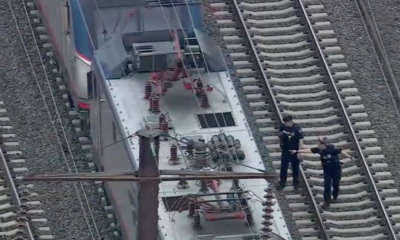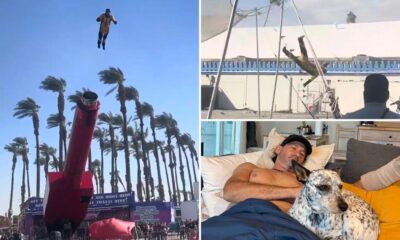Breaking News
He Was Pushed in Front of a Subway Train. How Did He Survive?

Joseph Lynskey was standing on the platform of the 18th Street subway station in Manhattan, waiting for a train to take him to Brooklyn on the afternoon of Dec. 31.
He had just had lunch with friends and was headed home to get ready for a New Year’s Eve party.
Suddenly he found himself in midair above the tracks. He saw the lights of an oncoming train, so close that he could make out the shape of the train’s operator. He did not expect to survive.
“My life did not flash before my eyes,” he said. “My thought was ‘I’ve been pushed, and I’m going to get hit by the train.’”
His head, and then his body, crashed into the ground between the tracks. Blood pooled beneath his skull. The wetness, and the searing pain, let him know he was alive.
But when he opened his eyes, he saw that he was not out of danger. “I looked up, and I was underneath the 1 train,” he said.
For many New Yorkers, there is nothing quite so terrifying as the thought of being shoved into the path of an oncoming train. Mr. Lynskey survived such an attack — and he emerged with a unique perspective on a crisis that has created intense anxiety for the city’s residents, officials and tourists.
But surviving the push was only the first hurdle. Mr. Lynskey then had to find a way to get extricated from what was nearly his grave.
In New York City, the fear of crime in the subway system is not new. But in recent years — and especially since the pandemic — those fears have been amplified amid a series of high-profile random attacks on riders.
Last year, people were pushed to the tracks 26 times, including those propelled off the platform during fights. Few people shoved directly into the path of a train survive.
But then there is Mr. Lynskey.
Somehow he lived through an assault that, when viewed on video, seems unsurvivable. “A fraction of a millisecond, and that train probably would have ended my life or paralyzed me,” he said. He is not sure how to make sense of it. “I survived. I don’t know how I did.”
A suspect, Kamel Hawkins, 23, was apprehended by the police later that day. He has pleaded not guilty to second-degree attempted murder, assault and attempted assault.
Last week, Mr. Lynskey, 45, shifted uncomfortably on the couch of his sunny Brooklyn apartment, occasionally wincing in pain as he recounted with vivid detail the harrowing ordeal that left him with four broken ribs, a fractured skull, a ruptured spleen, a concussion and psychological trauma.
No one could fault him if he joined a chorus of doomsayers who condemn the subway system as a lawless labyrinth.
Yet far from disparaging his city, Mr. Lynskey, who has long been a super-user of the subway, articulated a different message: that the subway system is vital to New York’s greatness and that New Yorkers like him deserve urgent action from city and state officials who have not done enough to address the violence.
“The subway is the lifeline of this city,” he said. “I don’t think any New Yorker should have to stand against a wall or hold on to a pillar to feel safe as the train approaches.”
He added: “Unacceptable. Do better. Protect your citizens.”
Family, Madonna and tennis
Mr. Lynskey moved to New York from Miami when he was 20, packing a U-Haul and driving from South Beach to the South Slope in Brooklyn. He had been working as a music producer and quickly integrated himself into the New York nightclub and music production scenes.
He is now the head of content and music programming at Gray V, a company that creates background music and playlists for hotels, restaurants, gyms and retail businesses. (Mr. Lynskey is responsible for Carnival Cruise Line and Equinox fitness club playlists.) He still occasionally performs as a D.J. under the stage name DJ Joe Usher.
His studio apartment near Fort Greene Park is tidy and appointed to reflect his life and passions. On a bookshelf — near his favorites, which include “The Great Believers,” by Rebecca Makkai and “The Night of the Gun” by David Carr — is a photo of his parents at their high school prom, before they married and raised Joseph and his 11 siblings in Miami. A turntable and collection of vinyl are beneath the window. A tennis racket hangs from a wall, as do several photographs of Madonna. “Her music has gotten me through a lot in my life,” he said.
In 2012, after years of clubbing and partying, Mr. Lynskey quit drinking. “A life free of hangovers is one of the greatest gifts of recovery,” he said. His life is now centered on his dog, his family, work, working out, going to museums and musical performances, and travel. (After the attack, he postponed a hiking trip planned for this month to Patagonia, in South America).
A tennis obsessive since he was 8 years old, Mr. Lynskey is also an active member of Metropolitan Tennis Group, a club for LGBTQ+ tennis players and fans. “If it’s above 30 degrees,” he said, “I’ll play.”
For years he has taken the subway to public courts across the city.
‘I felt the hardest shove’
On Dec. 31, Mr. Lynskey started his day with a workout in his apartment building’s gym. He then hopped an express train to Manhattan to meet friends for lunch in Chelsea. At Da Andrea, on the corner of West 18th Street and Eighth Avenue, he enjoyed pappardelle with meat sauce and chatted for a little over an hour.
Afterward, he and Mark Murashige, one of his best friends, headed east toward Seventh Avenue. He had planned to walk to West 14th Street, to get on an express train back to Brooklyn. But at the entrance to the 18th Street station, he peered down the stairs and saw an alert that a train was coming in one minute.
Cold, he decided to take the local 1 train for one stop to 14th Street and transfer to a Brooklyn-bound express train. He hugged Mr. Murashige goodbye and bounded down the stairs.
When he reached the turnstiles, he could hear the vibrations indicating the train was making its approach. He remembers seeing no one else on the platform — no other passengers, no police officers, no Metropolitan Transportation Authority employees. He was there for perhaps 45 seconds in total, he said. He glanced quickly at Spotify on his phone but had not yet put in his earbuds.
“I could hear and see the train coming,” he said. “I probably looked at my phone for, I don’t even know, 10, 15 seconds.
“Then I felt the hardest shove,” Mr. Lynskey said. “I wasn’t braced for anyone to attack me. I’m a strong guy, but I was pushed extremely hard and from behind.
“And I flew through the air.”
He landed on his left side in the trench. His head and ribs smashed to the ground. He looked up and saw the train over him. And he glimpsed the third rail just inches away. He knew it could electrocute him if his body or even his puffer jacket touched it.
He kept himself as still as possible and began to scream: “I’ve been pushed! Someone, please, please help me!’”
He heard the voices of a man and a woman — he does not know if they were calling to him from the space between cars in the train above him, or if they were on the platform.
“She asked me if I was OK, and I started screaming that yes, I was OK, but ‘Please help me!’” he said. “She asked me my name. She asked me to spell my name. She asked me to wiggle my toes. She asked me to wiggle my fingers.”
Mr. Lynskey estimates that he was under the train four or five minutes before he heard sirens and then “absolute chaos” from the platform.
The firefighters Johnathon Aquilina and John Montalbano were among the emergency workers who raced to the scene. In a small gap between two train cars, they said in interviews, they could see Mr. Lynskey’s head, gashed and bleeding. He did not appear to be conscious.
The night before, in a drill at their firehouse, the firefighters had practiced rescuing people trapped beneath or beside a train. They knew that anyone in a subway trench risked electrocution from the third rail or the subways “shoes” — metal pieces that conduct electricity between the third rail and the train car.
They had a quick exchange with their boss about asking the M.T.A. to shut down the electricity. But then they saw Mr. Lynskey open his eyes and felt they had no time to wait.
“We had to get down there,” Mr. Montalbano said.
The firefighters lowered themselves under the train and into the trench, which was less than 10 inches deep.
“We need to get you the hell out,” Mr. Lynskey recalled their saying.
But they told him he needed to stay perfectly still. All their lives were at risk because if Mr. Lynskey touched the third rail while the rescuers were touching him, they all could be electrocuted.
“It’s very high stakes,” Mr. Montalbano said.
Once they were under the train with Mr. Lynskey, Mr. Aquilina said, “we determined that we could just drag him out quickly and kind of lift him up in between the cars.”
They dragged him by his arms for about eight feet, and then other emergency workers pulled him up onto the platform.
That is when Mr. Lynskey felt his ribs crack open.
Rescue workers sheared his clothes off him with scissors, put a brace around his neck and laid him on a board. Mr. Lynskey said he was less worried about himself than about Leo, his 16-year-old dachshund, home alone in Brooklyn.
“I’m in my underwear on the platform just begging for help,” he said. “I said to the F.D.N.Y., ‘I know I’m really hurt, but can we make sure that someone is going to be able to get to my dog?’”
Mr. Lynskey was rushed to Bellevue Hospital, where he was given a battery of tests and then questioned by the police, who told him they had arrested a suspect at a Midtown train station. His 37-year-old nephew, who had been visiting the city with his wife for the holiday, was by his bedside within an hour. Later, Mr. Murashige sat with him, and they watched from the window of the intensive care unit as the lights of the Empire State Building marked the new year.
Just after midnight, Kathleen Mank, one of Mr. Lynskey’s older sisters, walked into his hospital room. She had flown in from Florida. They both began to cry.
“It was a very rough first 24 hours,” Ms. Mank said. He was given morphine for his physical pain, but her brother’s anguish could not be dulled. “He kept repeating, ‘Why did he try to kill me?’” she said.
Three weeks later, she herself can hardly wrap her brain around the fact that her brother was pushed into train tracks, run over by a train and had lain injured just inches away from an electrified third rail.
-

 Destination8 months ago
Destination8 months agoSingapore Airlines CEO set to join board of Air India, BA News, BA
-

 Breaking News9 months ago
Breaking News9 months agoCroatia to reintroduce compulsory military draft as regional tensions soar
-

 Tech News11 months ago
Tech News11 months agoBangladeshi police agents accused of selling citizens’ personal information on Telegram
-

 Breaking News9 months ago
Breaking News9 months agoBangladesh crisis: Refaat Ahmed sworn in as Bangladesh’s new chief justice
-

 Productivity11 months ago
Productivity11 months agoHow Your Contact Center Can Become A Customer Engagement Center
-

 Toys11 months ago
Toys11 months ago15 of the Best Trike & Tricycles Mums Recommend
-

 Guides & Tips9 months ago
Guides & Tips9 months agoHave Unlimited Korean Food at MANY Unlimited Topokki!
-

 Gadgets3 months ago
Gadgets3 months agoSupernatural Season 16 Revival News, Cast, Plot and Release Date
























